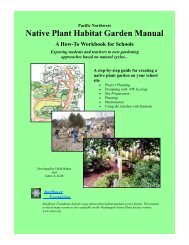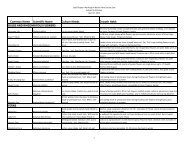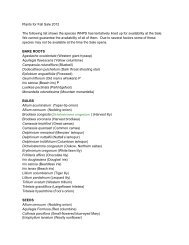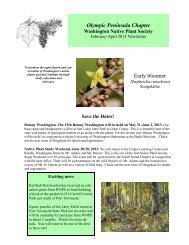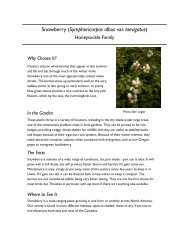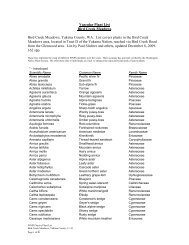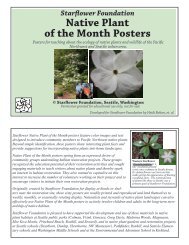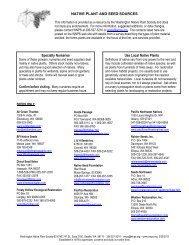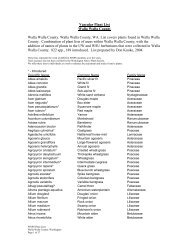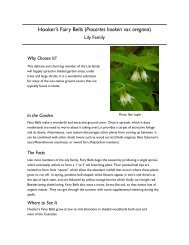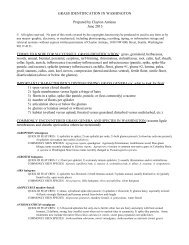Taking students outside createsopportunities for memorablemoments and time for refl ection(above and below).Outdoor ResourcesTaking Students OutdoorsOutside the door of most classrooms are a variety of opportunities fortaking students outdoors. School grounds and public parks are especially richareas for outdoor classroom activities.At each grade level, the first Q&E activity serves as an introductoryetiquette activity to help students establish an outdoor ethic and develop anawareness of appropriate behavior while visiting habitat areas. These etiquetteactivities are appropriate to the grade level and tie to the theme of the series.Students can be reminded of this etiquette activity throughout the unit asneeded to help modify behavior.When taking students outdoors it is important to tell students that the rulesof the classrrom apply equally to outdoor classrooms. Emphasize that the outdoortime is not a ‘recess’ or a ‘camp’ experience where boisetrous games andsporting activities are often an expectation. Instead the ‘outdoor classroom’ isa place to study and appreciate nature.While it is important to emphasize appropriate outdoor behavior, makesure to explain that the rules are to protect the animals and plants that livein the area. Students have misunderstood the rules to mean that wild areasare unsafe and that plants are harmful. “Stay on the trail!”, “Don’t touch theplants!”and “Don’t pick the berries, they might be poisonous!” can soundalarming. Also encourage students to come back with their families and enjoymore intimate exploration and experiences.School Grounds for Outdoor <strong>Education</strong>Outdoor education opportunities vary from school to school and overtime. Many schools have developed wonderful nature classrooms, with nativeplant gardens or greenbelt restorations on school grounds. Some schools havealready been landscaped with native plants. Even small landscapes provideopportunities to observe soil invertebrates, wildlife, plant growth, seasonalvariations as a component of Q&E activities. Uncovering opportunitiessometimes takes close observation. We have worked at schools with dozens ofnative plant species already occurring in their mature landscapes, though mostschool staff were unaware that this resource was at their front door. Manyschools have greenbelts included on the school grounds which provide opportunitiesto implement all of the Q&E activities.Developing school native plant gardens provides amazing learning and theresulting gardens offer many advantages over using nearby parks or habitatareas. The following are a few of the primary advantages of using schoolgrounds for Q&E activities:School gardens can beconvenient and used forproject-based learning(right).
• Proximity to classroom for short, frequent or impromptu visits• Potential for a strong sense of stewardship• Ability to harvest from plants (berries, leaf pressing, seeds, etc.), especiallyif designed as food or ethnobotany resource gardens.• Hardscape enhancements such as pathways, signage, fencing and seatingare easier to implement with more available resources and a lessrestrictive approval process.Public Parks for Outdoor <strong>Education</strong>The Seattle urban area is dotted with dozens of small to large parks, manyof which contain natural habitat areas with native plantings. In the past decadethere have been hundreds of restoration projects at these parks, restoring nativeplant communities and their associated wildlife communities. In many locations,it is possible to walk a few blocks from school and encounter a rangeof wildlife from dragonflies to bald eagles, hummingbirds to blue herons,squirrels to muskrats, and Pacific chorus frogs to turtles. The plant diversityin restorations has increased to include hundreds of species of native plants,many of which were extirpated in the early part of the last century.Seattle natural areas were preserved as early as 1903 and some have remnantold growth forests. These are true gems in the middle of the Seattle urbanarea and include Seward and Schmitz park. Others have had 80-90 years togrow back from logging and now have mature second growth plant communities.Stewardship groups have worked hard to restore the plant diversity,removing non-native invasive plants such as blackberry and ivy. Schoolswithin walking distance of parks that have natural habitat areas, or are undergoinghabitat restoration, are wonderful resources for implementing educationactivities. Major parks such as Seward Park and <strong>Washington</strong> Park Arboretumare worth a bus ride for special field trips. Some considerations for visitingSeattle parks for education activities include:• Students can see large, working plant communities and study theirecology.• Wildlife sightings of unusual urban wildlife such as eagle, muskrat,salmon and heron are more likely in larger natural areas.• Comparisons can be made to school ground habitats and plants.• Most Seattle parks have associated stewardship groups or parks staffthat can host classes, assist with implementing Q&E or other outdooractivities, or provide student stewardship activities such as native plantingsand non-native plant removal. Q&E activities provide ideal linksto stewardship activities as students rotate through ‘work stations’ and‘education stations’.Basic OutdoorEtiquette• Stay on trails: heavy traffic has a majorimpact on soils compaction, disturbswildlife breeding and raising of young,and harms plant growth, especially themore tender groundcover plants.• Do not collect living plant material inpublic parks. Uprooting, damaging or collectingplant materials is forbidden in city,county and state parks. While it is okay tocollect berries, be sure to know the identityof any berry before eating. And makesure to leave plenty for the wildlife.• When traveling in large groups alongtrails be sure to allow right of way forother park users. Typically people travelalong their right side of the path, allowingothers to pass on the left.• Do not chase, follow or collect wildlife.<strong>Native</strong> wildlife is protected by law,and harassment by humans and pets is illegal.If you suspect you are near a denor nest of wildlife, leave them plenty ofroom. Wildlife includes frogs, turtles, butterfliesand other fascinating, previouslycommonly collected creatures.• Keep dogs on leash, or preferablyat home. Though dogs do not usually accompanyschool groups, occasionally parentvolunteers may bring their pets. Dogsare far more threatening to wildlife thanhumans and will hamper opportunities toview wildlife.• Keep noise levels down for otherpark or school grounds occupants, bothanimal and human.Creating outdoor seating areas can help manage students.Q&E’s are designed to require aminimum of supplies.



